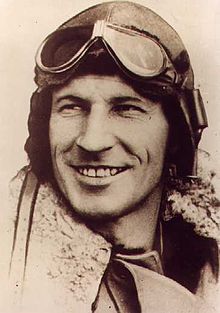Sir Charles Kingsford Smith
| Sir Charles Kingsford Smith | |
|---|---|

Kingsford Smith in his flying gear
|
|
| Full name | Charles Edward Kingsford Smith |
| Born |
9 February 1897 Hamilton, Brisbane, Queensland, Australia |
| Died | 8 November 1935 (aged 38) Andaman Sea |
| Cause of death | Crashed in the sea off Burma |
| Nationality |
British subject Australian |
| Aviation career | |
| Known for | First non-stop crossing of the Australian mainland Trans-Pacific flight England to Australia air race |
| Air force |
Australian Flying Corps Royal Flying Corps Royal Air Force |
| Battles |
World War I |
| Rank |
Captain (substantive) Air Commodore (honorary) |
| Awards |
Knight Bachelor Military Cross Air Force Cross Segrave Trophy |
World War I
Sir Charles Edward Kingsford Smith MC, AFC (9 February 1897 – 8 November 1935), often called by his nickname Smithy, was an early Australian aviator. In 1928, he earned global fame when he made the first trans-Pacific flight from the United States to Australia. He also made the first non-stop crossing of the Australian mainland, the first flights between Australia and New Zealand, and the first eastward Pacific crossing from Australia to the United States. He also made a flight from Australia to London, setting a new record of 10.5 days.
At 16, Kingsford Smith became an engineering apprentice with the Colonial Sugar Refining Company. In 1915, he enlisted for duty in the 1st AIF (Australian Army) and served at Gallipoli. Initially, he performed duty as a motorcycle despatch rider, before transferring to the Royal Flying Corps, earning his pilot's wings in 1917.
In August 1917, while serving with No. 23 Squadron, Kingsford Smith was shot down and received injuries which required amputation of a large part of his left foot. He was awarded the Military Cross for his gallantry in battle. As his recovery was predicted to be lengthy, Kingsford Smith was permitted to take leave in Australia where he visited his parents. Returning to England, Kingsford Smith was assigned to instructor duties and promoted to Captain.
On 1 April 1918, along with other members of the Royal Flying Corps, Kingsford Smith was transferred to the newly established Royal Air Force. On being demobilised in England, in early 1919, he joined Tasmanian Cyril Maddocks, to form Kingsford Smith, Maddocks Aeros Ltd, flying a joy-riding service mainly in the North of England, during the summer of 1919, initially using surplus DH.6 trainers, then surplus B.E.2s. Later Kingsford Smith worked as a barnstormer in the United States before returning to Australia in 1921. He did the same in Australia and also flew airmail services, and began to plan his record-breaking flight across the Pacific. Applying for a commercial pilot's licence on 2 June 1921 (in which he gave his name as 'Charles Edward Kingsford-Smith'), he became one of Australia's first airline pilots when he was chosen by Norman Brearley to fly for the newly formed West Australian Airways.
...
Wikipedia
